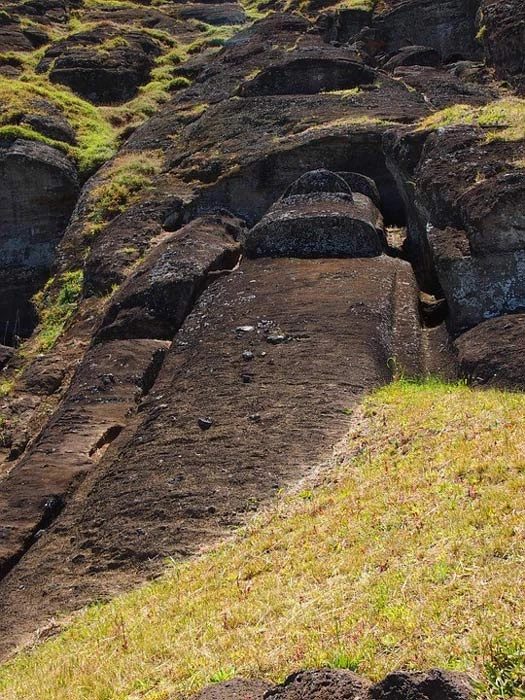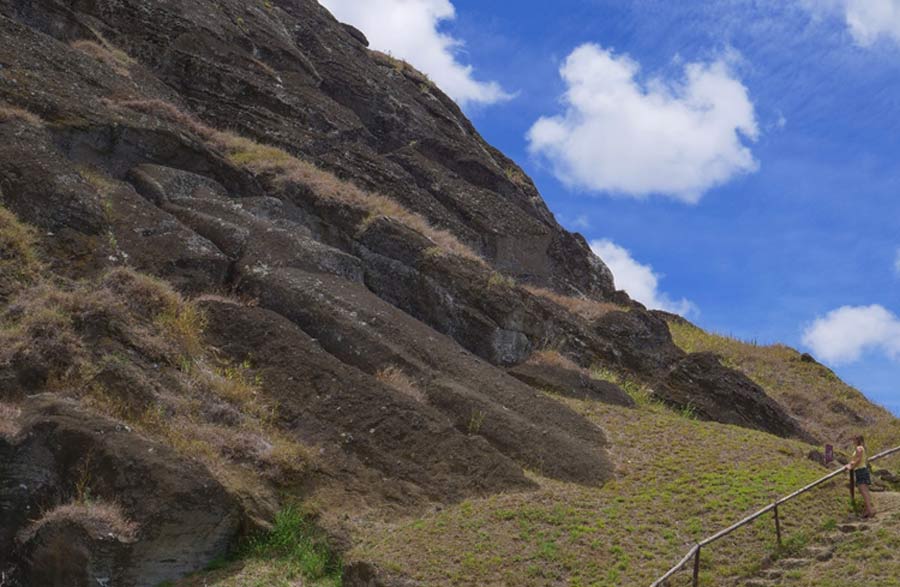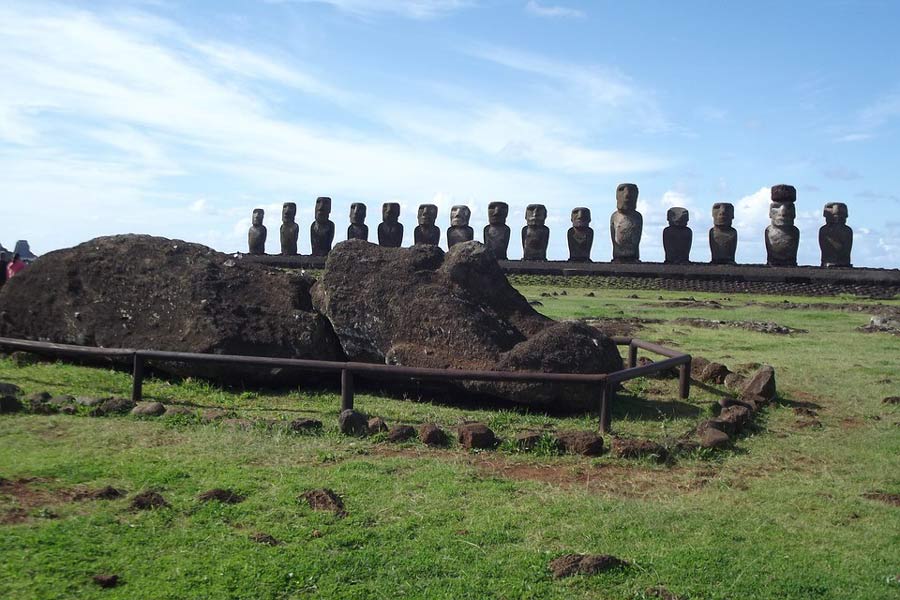El Gigante is the largest of the Moai: the massive stone sculptures found on Easter Island. It is located near the Rano Raraku Quarry, in a volcanic crater on the island’s southeastern coast, and even in its unfinished state it is magnificent.
If completed it would have stood fully 72 feet (22 meters) tall and it weighs as much as 200 US tons (182 metric tons), more than two fully laden 737 airplanes. But it never left the quarry in which it was mined, and it never stood as intended amidst the landscape.
Why this happened is something of a mystery. It is certainly possible that even the master engineers of Easter Island were not able to move it owing to its astonishing size. However the real reason why El Gigante was left unfinished is still unknown, and many researchers actually believe that it was never intended to be finished.
What Were the Moai?
The Moai were monolithic human figures on Easter Island that were carved by the Rapa Nui people from 1250 to 1500 AD. Hundreds of these Moai were carved, and have been transported and set on different stone platforms around the periphery of the island, but fully half of them are still present at Rano Raraku.
The monolithic statues were made from volcanic rock. At first, a human figure was outlined on the rock wall and then chipped away to leave behind the image only. Then the rest of the carving was completed to free the figure from the surrounding material.
The features of the statues are highly stylized, but show an impressive degree of uniformity. The over-large heads of the statues have elongated noses and heavy brows. The lips are protruded and formed a thin pout. The ears of the monolithic statues are oblong and elongated like the nose. The hands have slender fingers that rest along the hip’s crest.
However, other aspects of the statues are underdeveloped. The anatomical features of the back of the Moai are not detailed. Moreover, most of the Moai do not possess visible legs, except the kneeling Moai.

Even though the Moai are statues that have a whole body, they are often called “Easter Island heads.” It is mainly because of the disproportionate size of the heads, and is also because the statues are often found sunken into the ground with little more than their heads visible.
- Easter Island History – From Settlement to Collapse
- The Sky Fortress Of Kuelap And Cliffside Mummies Of The Chachapoyas
But, even accounting for the larger part of the statues being below ground, most Moai are dwarfed by El Gigante. This huge statue would have been some six times taller than the average Moai.
The Symbolism of the Monolithic Statues
According to a number of archaeologists, the monolithic human figures symbolize the spirits of high-ranking chiefs and ancestors who lived in the primeval Easter Island. The statues are known to be the symbol of power and authority, both in terms of political as well as religious aspects.
However, the Moai were actually much more than just symbols. For the people who used and erected the monolithic statues, they were thought of as the real, tangible repositories of a sacred spirit. As per the ancient Polynesian religions, the wooden objects and carved stones, when ritually prepared and properly fashioned, were thought to be charged by mana, a magical spiritual essence.
The monolithic statues faced towards the village as if they were keeping a watch over the people who lived there. However an exception to this is found with the seven statues of Ahu Akivi which face towards the sea. It is believed that it helps travelers in easily finding the island.
According to a legend, these were seven men who continuously waited for the arrival of their king. They still wait, facing eternally outwards, for someone who will never come.
However, the statues were thought to hold more practical uses as well. A study conducted in 2019 concluded that according to the beliefs of the people who built them, the quarrying of Moai would help in enhancing soil fertility and therefore increase food supplies.
El Gigante
While the real reason as to why the El Gigante of Easter Island was left unfinished, a number of potential reasons have been identified. One of the reasons could be that the monolithic statue was never intended to be completed.

Another reason is that inclusions may have been encountered in the rock, due to which the carvers abandoned the partial statue and went on to start a new one. Yet another reason is that the statue-building era might have come to an end, leaving behind El Gigante as the last of a tradition that had died out.
- Undecipherable Rongorongo Script of Easter Island
- Olmec Civilization: Their Rise, Culture and Decline
But perhaps the problem was after all a practical one: how were the carvers going to move this huge statue? The method that the smaller Moai were moved is still something of a mystery, and there are a number of theories that have been proposed.
As the island was treeless at the time when the Europeans visited Easter Island first, the movement of the monolithic statues remained a mystery for quite a long time. But a modern pollen analysis revealed that, until 1200 AD, the island was completely forested.
The exact way in which the Moai were transported is not known. However, researchers, faced with evidence of sudden deforestation, believe that the trees may have been used to move them. Ropes and wooden sledges or rollers have been suggested, or perhaps the statues were placed on logs and then made to roll towards the desired destination.
In case this theory is true, it would require nearly 50 to 150 people in order to move the monolithic statues to the destination. It is also entirely possible that the Rapa Nui chopped down every tree on the island to transport their Moai, dooming themselves in the process.
The Walking Moai
However, the coincidence of the last tree being cut down just before the largest statue was ready to be moved is too much for some, and indeed there are other stories as to how the Moai were moved. According to oral histories, people believed that the statues were made to “walk” to their destinations through commands of humans who had divine powers.
According to one of the earliest accounts, Tuu Ku Ihu, a king, made the Moai move with the help of god Makemake. As per later stories, there was a woman who lived on a mountain. She was able to order the Moai to move as per her own will.

Modern researchers, following this line of thought and other clues, have been able to “rock” a replica Moai from side to side with teams holding ropes. One rope was tied to the head of the statues, and another rope was tied around the base of the statue. Teams of workers together moved the statues by rocking and swiveling them from side to side. introducing forward motion and allowing the statue to “walk” forward.
This would provide an answer for the fate of El Gigante which would have been far too big to have moved in this way, something the carvers may not have appreciated. Whatever the reason, this huge statue will now never reach its intended destination. It is fated to forever lie amidst the stones it was carved from.
Top Image: Moai statues near the Rano Raraku quarry. Source: kovgabor79 / Adobe Stock.
By Bipin Dimri